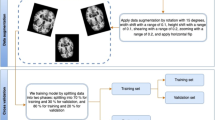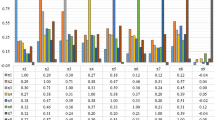Abstract
With more successful applications of advanced medical imaging technologies in clinical diagnosis, various analytic discriminant approaches, by seeking the imaging based characteristics of a given disease to achieve automatic diagnosis, gain greater attention in the medical community. However the existing computer-aided discriminant procedures for Alzheimer’s disease (AD) are yet to be improved for better identifying patients with mild cognitive impairment (MCI) from those with AD and those who are cognitively normal. In this work we present a computer assisted diagnosis approach by first statistically extracting characteristics from whole brain 2-deoxy-2-(18F)fluoro-D-glucose positron emission tomography (18F-FDG PET) images, and then using support vector machines for classification. Evaluations of the proposed procedure with patient data exhibit satisfactory accuracies in distinguishing AD from its early stage MCI, and normal controls.
Similar content being viewed by others
References
Alzheimer’s Association. 2013 Alzheimer’s disease facts and figures [J]. Alzheimer’s & Dementia, 2013, 9(2): 208–245.
Hampel H, Prvulovic D, Teipel S, et al. The future of Alzheimer’s disease: The next 10 years [J]. Progress in Neurobiology, 2011, 95(4): 718–728.
Reiman E M, Jagust W J. Brain imaging in the study of Alzheimer’s disease [J]. NeuroImage, 2012, 61(2): 505–516.
Querbes O, Aubry F, Pariente J, et al. Early diagnosis of Alzheimer’s disease using cortical thickness: Impact of cognitive reserve [J]. Brain, 2009, 132(8): 2036–2047.
Duara R, Grady C, Haxby J, et al. Positron emission tomography in Alzheimer’s disease [J]. Neurology, 1986, 36(7): 879–887.
Norderg A, Rinne J O, Kadir A, et al. The use of PET in Alzheimer disease [J]. Nature Reviews Neurology, 2010, 6(2): 78–87.
Jagust W J, Bandy D, Chen K, et al. The Alzheimer’s disease neuroimaging initiative positron emission tomography core [J]. Alzheimer’s & Dementia, 2010, 6(3): 221–229.
Foeter N L, Heidebrink J L, Clark C M, et al. FDG-PET improves accuracy in distinguishing frontotemporal dementia and Alzheimer’s disease [J]. Brain, 2007, 130(10): 2616–2635.
Du A-T, Schuff N, Kramer J H, et al. Different regional patterns of cortical thinning in Alzheimer’s disease and frontotemporal dementia [J]. Brain, 2007, 130(4): 1159–1166.
Dickerson B C, Feczko E, Augustinack J C, et al. Differential effects of aging and Alzheimer’s disease on medial temporal lobe cortical thickness and surface area [J]. Neurobiology of Aging, 2009, 30(3): 432–440.
Gray K R, Wolz R, Keihaninejad S, et al. Regional analysis of FDG-PET for use in the classification of Alzheimer’s disease [C]// 2011 IEEE International Symposium on Biomedical Imaging: From Nano to Macro. Chicago, USA: IEEE, 2011: 1082–1085.
Gray K R, Woiz R, Heckemann R A, et al. Multiregion analysis of longitudinal FDG-PET for the classification of Alzheimer’s disease [J]. NeuroImage, 2012, 60(1): 221–229.
Salmon E, Sadzot B, Maquet P, et al. Differential diagnosis of Alzheimer’s disease with PET [J]. Journal of Nuclear Medicine: Official Publication, Society of Nuclear Medicine, 1994, 35(3): 391–398.
Mosconi L. Glucose metabolism in normal aging and Alzheimer’s disease: Methodological and physiological considerations for PET studies [J]. Clinical and Translational Imaging, 2013, 1(4): 217–233.
Illán I, Gorriz J, Lopez M, et al. Computer aided diagnosis of Alzheimer’s disease using component based SVM [J]. Applied Soft Computing, 2011, 11(2): 2376–2382.
Kim E J, Cho S S, Jeong Y, et al. Glucose metabolism in early onset versus late onset Alzheimer’s disease: An SPM analysis of 120 patients [J]. Brain, 2005, 128(8): 1790–1801.
Kono A K, Ishii K, Sofue K, et al. Fully automatic differential diagnosis system for dementia with Lewy bodies and Alzheimer’s disease using FDG-PET and 3D-SSP [J]. European Journal of Nuclear Medicine and Molecular Imaging, 2007, 34(9): 1490–1497.
Reiman E, Chen K, Liu X, et al. Fibrillar amyloid-β burden in cognitively normal people at 3 levels of genetic risk for Alzhimer’s disease [J]. Proceedings of the National Academy of Sciences, 2009, 106: 6820–6825.
Noushath S, Hemantha K G, Shivakumara P. (2D)2 LDA: An efficient approach for face recognition [J]. Pattern Recognition, 2006, 39(7): 1396–1400.
Zoua H, Hastiea T, Tibshirania R, et al. Sparse principal component analysis [J]. Journal of Computational and Graphical Statistics, 2006, 15(2): 265–286.
Wang L. Support vector machines: Theory and applications [M]. Berlin: Springer, 2005.
Lopez M, Ramirez J, Gorriz J, et al. Automatic tool for Alzheimer’s disease diagnosis using PCA and Bayesian classification rules [J]. Electronics Letters, 2009, 45(8): 389–391.
Ramirez J, Gorriz J, Segovia F, et al. Computer aided diagnosis system for the Alzheimer’s disease based on partial least squares and random forest SPECT image classification [J]. Neuroscience Letters, 2010, 472(2): 99–103.
Author information
Authors and Affiliations
Corresponding author
Additional information
Foundation item: the National Natural Science Foundation of China (No. 81201114), the Shanghai Municipal Natural Science Foundation (No. 11ZR1416700), and the Innovation Program of Shanghai Municipal Education Commission (No. 13ZZ017)
Rights and permissions
About this article
Cite this article
Su, Ss., Chen, Kw. & Huang, Q. Discriminant analysis in the study of Alzheimer’s disease using feature extractions and support vector machines in positron emission tomography with 18F-FDG. J. Shanghai Jiaotong Univ. (Sci.) 19, 555–560 (2014). https://doi.org/10.1007/s12204-014-1540-4
Received:
Published:
Issue Date:
DOI: https://doi.org/10.1007/s12204-014-1540-4




